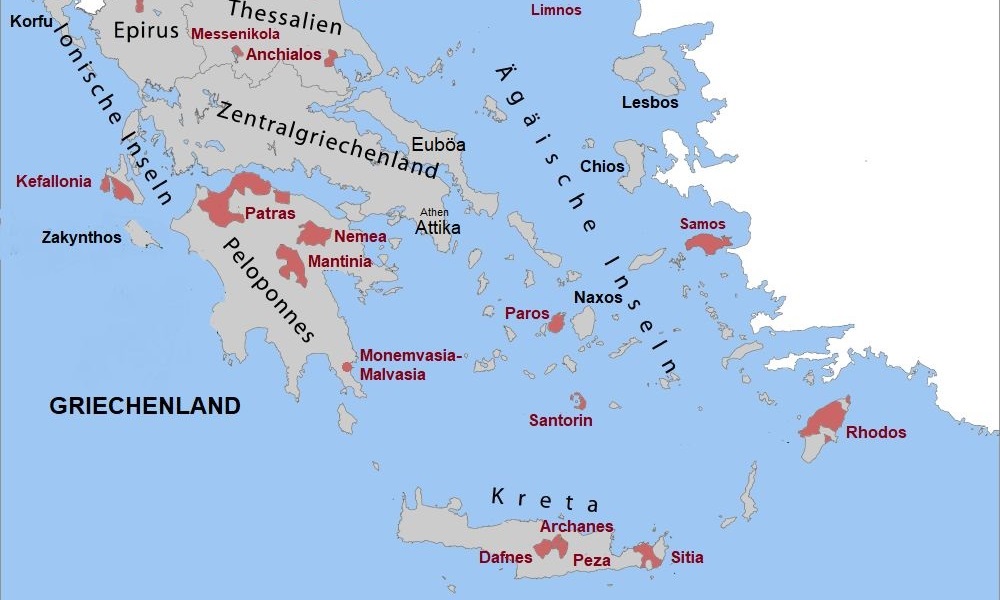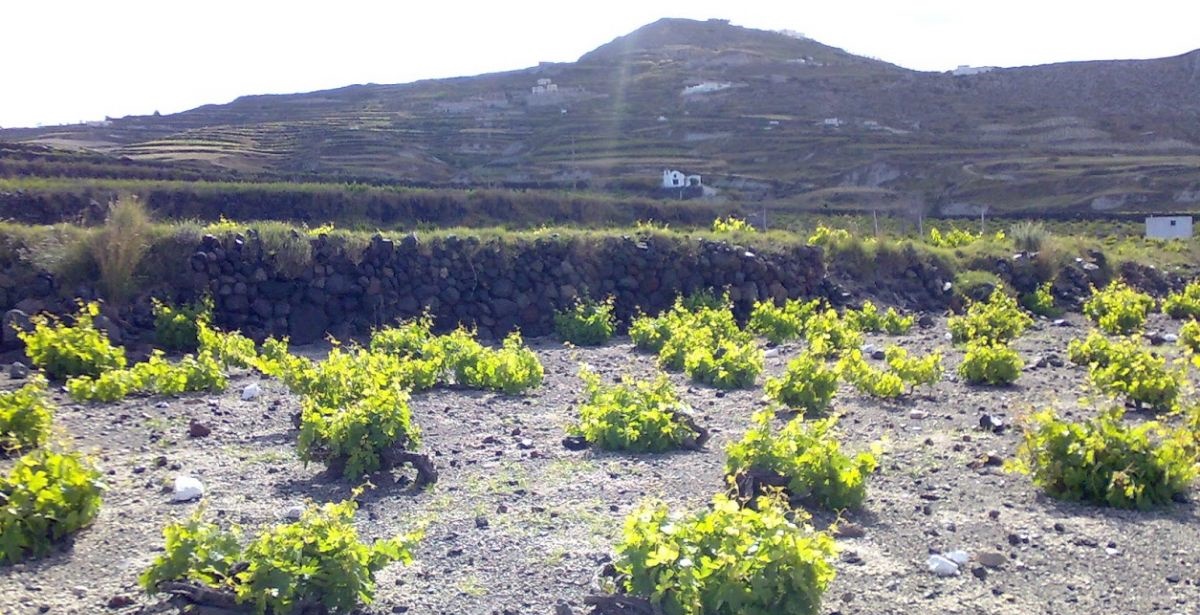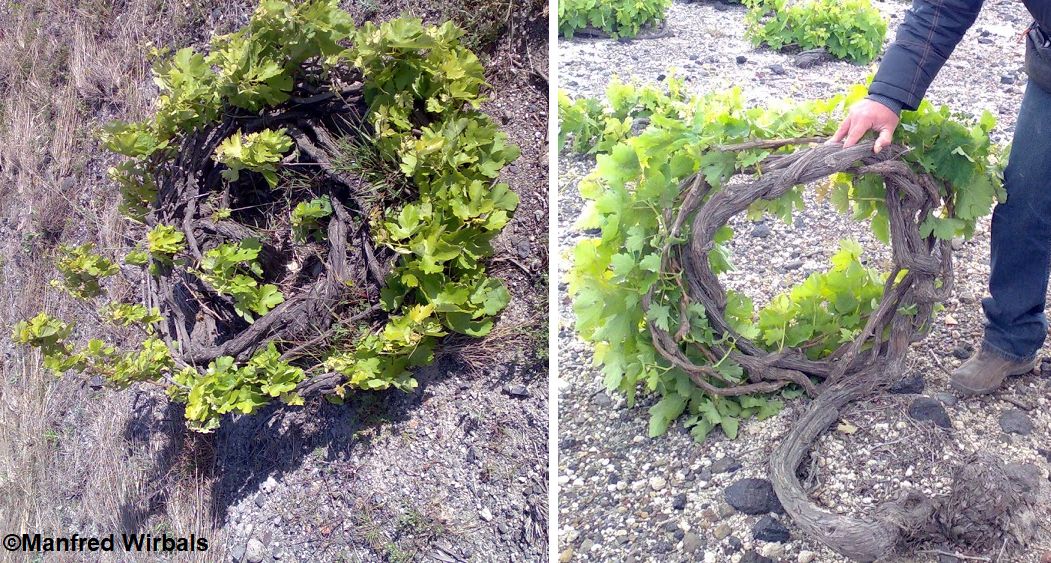Results
2,284 Results
Loading more Results ...
Loading more Results ...
Greece Aegean islands / Νησιά Αιγαίου
P.D.O. Santorini (O.P.A.P.) / Σαντορίνη
| P.D.O. Santorini (O.P.A.P.) / Σαντορίνη |
Description to P.D.O. Santorini (O.P.A.P.) / Σαντορίνη
The Greek archipelago (also known as Sandorini or Santorini) in the Aegean Sea covers around 90 km². It is the southernmost of the Cyclades group and lies around 100 kilometres north of Crete. The crescent-shaped main island is called Thira and forms a basin with the two islands of Aspronisi (0.14 km²) and Thirasia (9 km²). The ring-shaped island was created by a huge volcanic explosion around 1500 BC, which destroyed the Minoan civilisation (Bronze Age culture).

From the beginning of the 13th to the end of the 16th century, the island was strongly influenced by Venice, which led to the development of an important wine-growing culture. At that time it was named after Santa Irene (St Irene). The high-alcohol sweet wines in particular were highly prized and were shipped to many European countries via the harbour town of Monemvasia (Peloponnese). Although the island was conquered by the Turks in 1579, there were no restrictions on viticulture. Ottoman rule lasted until the Greek revolution in 1821.
Climate, soils and grape varieties
The summer is warm and dry with almost no rainfall, the winter is mild with little but heavy rainfall. Around 1950, there were still 4,800 hectares of vineyards, but these have shrunk to around 1,200 hectares due to the construction boom. Around 30 indigenous grape varieties are cultivated on mainly volcanic soil, which is ideal for viticulture. The porous soil has a good water retention capacity.
Numerous canavas (caves) have been created in the soft material, which are often used as wine cellars. The vines are cultivated ungrafted because the island has been spared from phylloxera. White wine varieties are cultivated to 80%. Assyrtiko dominates with 90%, followed by Aïdani Aspro and Athiri Aspro. These three are authorised for POP wines. The most important red wine varieties are Mandilaria, Mavrotragano and Athiri Mavro. The vines at vine training Kouloura are trained low in the form of crowns to protect the grapes growing inside from the strong, sandy winds. The yields are relatively low and the wines achieve high acidity levels.

Wine-growing areas
The main island of Santorini and the small island of Thirasia were declared an appellation in 1972. There is a white wine classified as POP in dry and sweet, which is blended from the varieties Assyrtiko (at least 75%), as well as Aïdani Aspro and Athiri (maximum 25%). The sweet version known as Vinsanto, made from dried grapes, has an ancient tradition here. This sweet wine probably served as a model for the Italian Vin Santo.
A speciality is the dry white wine "Nykteri" (night work), whose name refers to the fact that the grapes are only harvested after dusk and the work only ends in the early hours of the morning. It is matured in wooden barrels and stored for several years. The dry country wines are known as "Brousko" (from the Italian brusco = coarse, bitter). Various white wine varieties are harvested over a longer period of time and stored in open vats, which leads to oxidative processes. After pressing, the must ferments into a brownish-coloured, high-alcohol and tannin-rich wine with a rustic character.

Producers
The producers are Antoniou, Argyros, Avantis, Boutari, Gaia, Gavalas, Hatzidakis, Koutsoyiannopoulos Volcan Wines (with an integrated museum showing the island's winegrowing history from 1660 to 1970), Roussos, Santo Wines (a winegrowers' co-operative to which around 1,000 winegrowers supply grapes), Domaine Sigalas, Venetsanos and VSV.
Map of Greece: By Pitichinaccio - own work, CC BY 3.0, Link
edited by Norbert F. J. Tischelmayer 2/2018
Recent wines 131
 Hatzidakis Winery
— Aegean islands / Νησιά Αιγαίου
2004 P.D.O. Santorini (O.P.A.P.) / Σαντορίνη "Vinsanto 16"
Up to 40.00 €
Hatzidakis Winery
— Aegean islands / Νησιά Αιγαίου
2004 P.D.O. Santorini (O.P.A.P.) / Σαντορίνη "Vinsanto 16"
Up to 40.00 €

 Hatzidakis Winery
— Aegean islands / Νησιά Αιγαίου
2018 P.D.O. Santorini (O.P.A.P.) / Σαντορίνη "Nikteri / Νυχτερι"
41.90 €
Hatzidakis Winery
— Aegean islands / Νησιά Αιγαίου
2018 P.D.O. Santorini (O.P.A.P.) / Σαντορίνη "Nikteri / Νυχτερι"
41.90 €

 Santo Wines
— Aegean islands / Νησιά Αιγαίου
2019 P.D.O. Santorini (O.P.A.P.) / Σαντορίνη Assyrtiko trocken
16.00 €
Santo Wines
— Aegean islands / Νησιά Αιγαίου
2019 P.D.O. Santorini (O.P.A.P.) / Σαντορίνη Assyrtiko trocken
16.00 €

 Hatzidakis Winery
— Aegean islands / Νησιά Αιγαίου
2019 P.D.O. Santorini (O.P.A.P.) / Σαντορίνη "Familia"
Up to 33.00 €
Hatzidakis Winery
— Aegean islands / Νησιά Αιγαίου
2019 P.D.O. Santorini (O.P.A.P.) / Σαντορίνη "Familia"
Up to 33.00 €

The most important grape varieties
More information in the magazine
- Wineflight through Thessaloniki Wine enjoyment between harbour, antiquity and concrete
- The collections and discoveries of the year Tasting season 2020/21
- In the land of the autochthones Greece
- On a quality course The Wines of Northern Greece
- Munich Wine Fair Greek wine reveals unknown specialities
- Santorini's Crater Wines Between a decline in area and a quality offensive
- From Cabernet, Stavroto, Limnio and Batiki The Wine Roads of Northern Greece
- Forest fires destroy vineyard in the Peloponnese The green hills of hope
- The "new" retsina Cult wine with cultural background
- March 2004 St. George wine